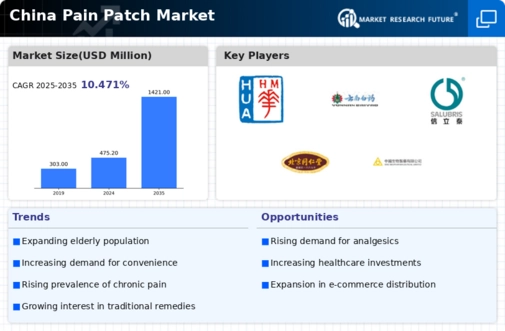Growing Aging Population
China's rapidly aging population is a crucial factor influencing the pain patch market. As the demographic of individuals aged 65 and older continues to expand, the prevalence of age-related ailments, including chronic pain, is expected to rise. This demographic shift creates a substantial market opportunity for pain management solutions, particularly pain patches, which offer a user-friendly and effective means of alleviating discomfort. The pain patch market is likely to benefit from targeted marketing strategies aimed at older adults, who may prefer non-invasive treatments. Current estimates suggest that by 2030, nearly 25% of China's population will be over 60, indicating a growing need for accessible pain relief options. This trend underscores the importance of adapting product offerings to meet the specific needs of this demographic.
Increasing Prevalence of Chronic Pain
The rising incidence of chronic pain conditions in China is a pivotal driver for the pain patch market. According to recent health statistics, approximately 20% of the adult population experiences chronic pain, which significantly influences the demand for effective pain management solutions. This growing prevalence necessitates innovative and accessible treatment options, thereby propelling the pain patch market forward. As healthcare providers seek to address this issue, the pain patch market is likely to see an uptick in product development and marketing efforts aimed at this demographic. Furthermore, the increasing awareness of chronic pain management among patients and healthcare professionals is expected to enhance the adoption of pain patches as a viable alternative to traditional pain relief methods.
Shift Towards Home Healthcare Solutions
The trend towards home healthcare in China is reshaping the pain patch market. With an increasing number of patients preferring to manage their health conditions at home, the demand for convenient and effective pain relief options is surging. Pain patches, known for their ease of use and non-invasive nature, align well with this shift. The pain patch market is witnessing a significant transformation as more consumers opt for self-administered treatments. Market data indicates that the home healthcare segment is projected to grow at a CAGR of 15% over the next five years, further emphasizing the potential for pain patches. This shift not only enhances patient comfort but also reduces the burden on healthcare facilities, making pain patches an attractive option for both patients and providers.
Increased Focus on Preventive Healthcare
The emphasis on preventive healthcare in China is driving changes in the pain patch market. As healthcare systems evolve, there is a growing recognition of the importance of managing pain before it escalates into more severe conditions. Pain patches, which can be used proactively to alleviate discomfort, are gaining traction among consumers and healthcare providers alike. The pain patch market is likely to see increased investment in research and development to create advanced formulations that cater to preventive care. Market analysis indicates that the preventive healthcare sector is expected to grow by 12% annually, highlighting the potential for pain patches to play a significant role in this paradigm shift. This focus on prevention not only benefits patients but also aligns with broader healthcare goals of reducing long-term treatment costs.
Rising Awareness of Alternative Therapies
The growing awareness and acceptance of alternative therapies in China are influencing the pain patch market. As consumers become more informed about various pain management options, there is a noticeable shift towards non-pharmaceutical solutions, including pain patches. This trend is supported by an increasing number of healthcare professionals advocating for integrative approaches to pain management. The pain patch market is likely to experience growth as more individuals seek out these alternatives, driven by a desire for fewer side effects and a more holistic approach to health. Recent surveys indicate that nearly 40% of patients are open to trying alternative therapies, suggesting a robust market potential for pain patches. This shift in consumer attitudes may lead to greater innovation and diversification within the pain patch market.
















Leave a Comment